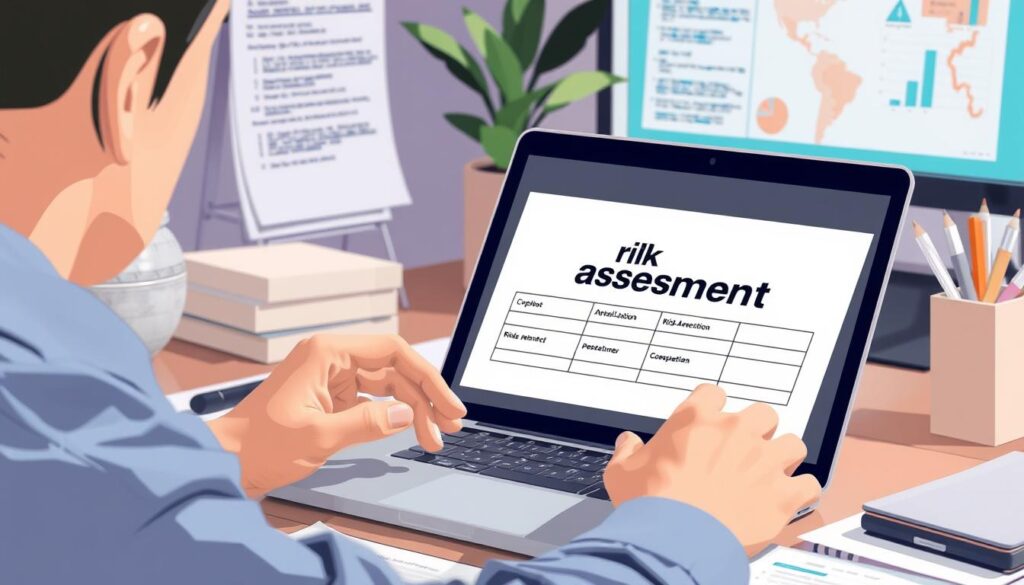Are you confident that your business is meeting its health and safety obligations? As a business owner, ensuring a safe working environment is not only a moral imperative but also a legal requirement. Conducting a thorough risk assessment is crucial to identifying potential hazards and implementing measures to mitigate them.
Every employer, including self-employed individuals, must comply with health and safety regulations by completing risk assessments. If you have five or more employees, it is a legal requirement to document your risk assessment. Even if you have fewer than five employees, writing down your risk assessment is considered good practice.
This comprehensive guide will walk you through the process of creating effective risk assessments for small jobs in your business, ensuring you maintain a safe working environment and comply with relevant regulations.
Key Takeaways
- Understand the importance of risk assessments in maintaining workplace safety.
- Learn how to identify potential hazards and implement control measures.
- Discover practical tools and templates to help you create risk assessments efficiently.
- Comply with health and safety regulations and avoid potential penalties.
- Add value to your small business operations by prioritising workplace safety.
Understanding Risk Assessments for Small Jobs
To ensure a safe and healthy work environment, it’s essential to grasp the concept of risk assessments for small jobs. A risk assessment is a systematic process that helps identify potential hazards and evaluate the risks associated with them.
What is a Risk Assessment?
A risk assessment involves a thorough examination of workplace activities to identify potential hazards and assess the risks they pose to people’s health and safety. This process includes determining who might be affected by these hazards and implementing reasonable measures to prevent or control the risks. For small jobs, risk assessments are typically more focused and straightforward than those for larger operations.
Why Risk Assessments Are a Legal Requirement
Risk assessments are not just a good practice; they are a legal requirement under the Management of Health and Safety at Work Regulations 1999 for all businesses, regardless of size. While businesses with fewer than five employees are not legally required to document their risk assessments, it is still advisable to keep written records. Understanding the difference between hazards (something with the potential to cause harm) and risks (the likelihood and severity of harm occurring) is fundamental to conducting effective assessments in the workplace.
The Importance of Risk Assessments in Small Businesses
For small businesses, implementing risk assessments is a key step towards ensuring workplace safety. By identifying potential hazards, you can take proactive measures to mitigate risks, thereby protecting your employees and business.
Preventing Workplace Accidents and Injuries
Risk assessments are crucial in preventing workplace accidents and injuries. By identifying potential hazards, you can implement controls to mitigate risks, creating a safer working environment for your employees. Effective risk assessments help you prioritise safety measures, making efficient use of your time and resources. This proactive approach not only safeguards your employees but also reduces the likelihood of accidents that could lead to costly compensation claims and increased insurance premiums.

Legal Compliance and Avoiding Penalties
From a legal perspective, risk assessments are not optional; they are a statutory requirement under UK health and safety legislation. Failing to conduct proper risk assessments can result in significant financial penalties. The Health and Safety Executive (HSE) can issue substantial fines for non-compliance, as seen in a recent case where a business was fined £274,000 after two workers became trapped in moving machinery. By conducting regular risk assessments, you demonstrate your commitment to employee welfare and compliance with legal requirements, thereby avoiding potential penalties.
| Benefits of Risk Assessments | Description |
|---|---|
| Prevents Workplace Accidents | Identifies potential hazards before they cause harm |
| Ensures Legal Compliance | Meets statutory requirements under UK health and safety legislation |
| Reduces Business Costs | Prevents accidents that lead to compensation claims and increased insurance premiums |
When to Write Risk Assessment for Small Jobs
Conducting a risk assessment at the right time is crucial for the success and safety of small jobs. You need to be aware of when to perform this critical task to ensure a safe working environment.
Before Starting New Activities or Projects
You should write risk assessment before commencing any new activity or project, regardless of how small the job might seem. This proactive approach helps identify potential hazards and implement necessary controls to mitigate risks. Introducing new equipment, materials, or processes into your workplace also necessitates a fresh risk assessment to identify any new hazards they might present.
After Workplace Changes
After making changes to your workplace layout, workflow, or staffing arrangements, you should review risk assessment to ensure it remains relevant. This includes assessing the impact of new equipment or processes on your activities and making necessary adjustments to control measures.
Periodic Reviews and Updates
Risk assessments should be reviewed periodically, with the frequency depending on the level of risk involved. Even when nothing has changed, regular reviews of existing risk assessments are necessary to ensure they remain valid and effective in controlling risks.
The 5-Step Risk Assessment Process
To ensure workplace safety, it’s essential to follow the HSE’s 5-step risk assessment process, a methodical approach to identifying and mitigating hazards. This structured process helps businesses manage risks effectively and maintain compliance with health and safety regulations.
Step 1: Identify the Hazards
The first step involves systematically identifying all potential hazards in the workplace. This can be achieved by walking around the workplace, observing activities, consulting employees, and reviewing accident records. By doing so, you can create a comprehensive list of hazards that need to be addressed.
Step 2: Determine Who Might Be Harmed and How
In this step, you need to determine who might be harmed by each hazard and how. Consider not just employees but also contractors, visitors, and vulnerable groups like pregnant workers or those with disabilities. Understanding who is at risk helps in implementing targeted control measures.
Step 3: Evaluate Risks and Implement Controls
Evaluating the risks involves considering both the likelihood of harm occurring and the potential severity of that harm. Once the risks are evaluated, you can implement appropriate control measures. It’s recommended to follow the hierarchy of control: elimination, substitution, engineering controls, administrative controls, and personal protective equipment, in that order of preference.
Step 4: Record Your Findings
Recording your significant findings is a legal requirement for businesses with five or more employees. Your written record should document the hazards identified, who might be harmed, the control measures in place, and who is responsible for implementing them. This record should be clear, accessible, and communicated to relevant employees.
Step 5: Review and Update as Necessary
Risk assessment is an ongoing process. You must review and update your assessment regularly and whenever there are significant changes to your workplace or activities. This ensures that your risk assessment remains relevant and effective in managing workplace hazards.
By following these five steps, businesses can ensure a thorough and effective risk assessment process, maintaining a safe working environment and complying with health and safety regulations.
How to Write Risk Assessment for Small Jobs Efficiently

Crafting a risk assessment for small jobs involves several key steps that must be followed meticulously. Before you start writing, it’s essential to understand that a risk assessment is not just about documenting hazards, but also about identifying and mitigating risks.
Gathering Essential Information Before Writing
Gathering all necessary information is crucial before you begin writing your risk assessment. You should start by understanding the complete process of the job, including all steps involved, the equipment used, materials handled, and the work environment. Consulting with the workers who perform the task is also vital, as they can provide valuable insights into potential hazards that may not be immediately apparent.
Structuring Your Risk Assessment Document
To structure your risk assessment document effectively, follow the five-step process recommended by the HSE. This includes clear sections for hazards, people at risk, control measures, and action plans. Organising your document in this manner will make it easier to follow and understand.
Using Clear and Concise Language
When writing your risk assessment, use clear, concise language that is easily understood by everyone who needs to read it. Avoid using technical jargon unless it is absolutely necessary. Be specific when describing hazards and control measures, as vague statements can be unhelpful. Including photographs or diagrams where appropriate can also enhance the clarity of your assessment.
By following these guidelines, you can create a comprehensive and effective risk assessment for small jobs, ensuring a safer working environment for everyone involved.
Practical Tools and Templates to Simplify Risk Assessments

To make risk assessments more manageable, several templates and tools can be utilised. These resources help streamline the process, saving time and ensuring compliance.
Risk Assessment Calculators
Risk assessment calculators are invaluable for quantifying and prioritising risks. By assigning numerical values to likelihood and severity, you can determine which hazards need immediate attention. This tool helps in making informed decisions about risk mitigation.
Pre-Completed Templates for Common Tasks
Using pre-completed templates for common tasks can significantly reduce the time spent on risk assessments. These templates provide a structured format with typical hazards and control measures already identified for standard activities. The HSE website offers free risk assessment templates that comply with UK regulations.
Digital Solutions for Risk Assessment Management
Digital solutions and mobile apps for risk assessment management enable real-time updates, easy sharing among team members, and convenient storage of assessment records. Cloud-based risk assessment tools facilitate collaboration between different sites or with external consultants.
By leveraging these tools and templates, you can simplify your risk assessment process, ensuring it is both efficient and effective. Always customise templates to reflect your specific workplace conditions and never use them as a substitute for actually conducting the risk assessment process.
Common Types of Risk Assessments for Small Businesses
Conducting risk assessments is a crucial aspect of maintaining health and safety in small businesses, and there are several types to consider. Depending on the nature of your business, you may need to undertake multiple risk assessments to ensure compliance with health and safety regulations.
Fire Risk Assessments
Fire risk assessments are mandatory for all workplaces. They involve evaluating fire hazards, identifying people at risk, assessing emergency routes, fire detection systems, and firefighting equipment. This helps prevent fires and ensures safe evacuation procedures are in place.
Manual Handling Risk Assessments
Manual handling risk assessments are essential for businesses where employees lift, carry, push, or pull items as part of their work. These assessments help prevent musculoskeletal disorders by identifying hazardous tasks and implementing control measures.
Display Screen Equipment (DSE) Assessments
DSE assessments are required for employees who regularly use computers or laptops. These assessments address ergonomic issues that could lead to repetitive strain injuries or visual fatigue, ensuring a comfortable working environment.
COSHH Risk Assessments
COSHH risk assessments are necessary when working with hazardous substances. They involve identifying substances that could harm health, assessing the risks, and implementing measures to control or eliminate these risks.
| Type of Risk Assessment | Purpose | Applicability |
|---|---|---|
| Fire Risk Assessment | Evaluate fire hazards and ensure safe evacuation | All workplaces |
| Manual Handling Risk Assessment | Prevent musculoskeletal disorders | Workplaces with manual handling tasks |
| DSE Assessment | Address ergonomic issues and prevent injuries | Workplaces with computer/laptop users |
| COSHH Risk Assessment | Control risks from hazardous substances | Workplaces using hazardous substances |
By understanding and implementing these common types of risk assessments, small businesses can significantly reduce workplace hazards and ensure a safer environment for their employees.
Communicating Risk Assessment Findings
Communicating the outcomes of risk assessments to employees is a vital step in ensuring a safe working environment. It’s not just about completing the risk assessment process, but also about ensuring that the identified controls are implemented effectively.
Sharing Results with Employees
You should share the findings of risk assessments with all employees who might be affected by the hazards. Using clear language and visual aids can help in understanding the risks and the measures to be taken.
- Consider different communication methods for different audiences.
- Involve employees in the risk assessment process from the beginning.
- Make sure risk assessment documents are easily accessible.
Training Staff on Control Measures
Providing specific training on the controls identified in the risk assessment is crucial. This ensures that workers understand both what to do and why it’s important.
| Training Method | Benefits |
|---|---|
| Toolbox Talks | Reinforces key safety messages |
| Brief Safety Meetings | Regularly updates workers on risk mitigation |
By focusing on health and safety, you can create a safer work environment.

Conclusion: Making Risk Assessments Work for Your Small Business
The key to a successful risk assessment lies in its implementation and regular review, making it a valuable tool for your small business. It’s essential to view risk assessments as practical processes rather than mere paperwork exercises. By doing so, you can ensure a safer workplace where accidents and ill-health are prevented.
To complete a risk assessment effectively, involve your employees in the process to improve the quality of the assessment and increase buy-in for implementing control measures. Regularly review risk assessments to ensure they remain relevant as your business evolves. For more information on how to complete risk assessments, visit BritSafe.
Make sure your risk assessments are working documents that inform day-to-day activities. By integrating risk assessments into your operations, you can improve efficiency, quality, and customer confidence. Over time, develop a systematic approach to risk assessment that becomes part of your organisational culture.


